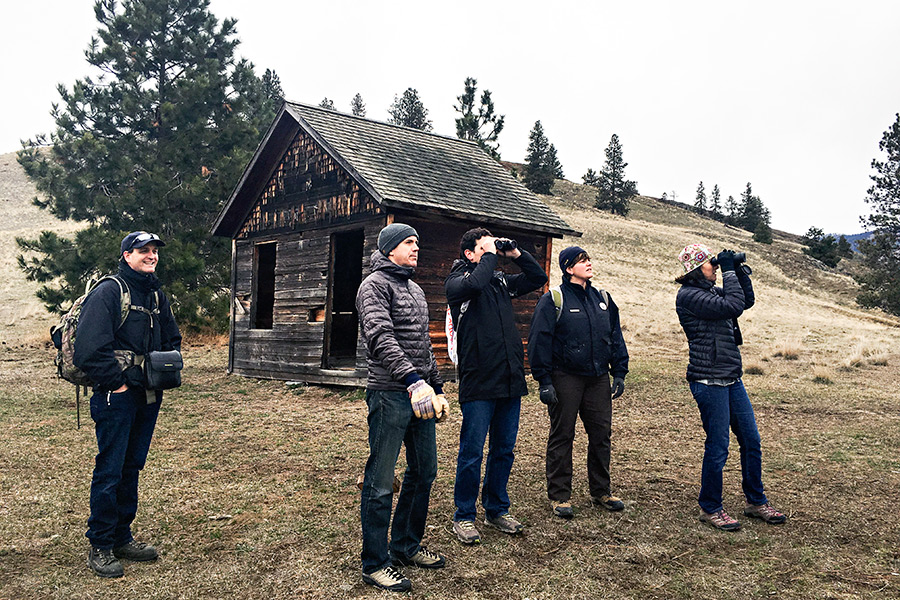As Outdoor Recreation Rises, Montana Grapples with Funding State Parks
Colorado outdoor recreation director touts “unique” local resources after touring Flathead Lake sites
By Dillon Tabish
BIG ARM — Hiking through the forested labyrinth of Wild Horse Island, Luis Benitez, the world-class mountaineer and outdoor recreation guru, pointed out something peculiar that caught his attention.
The primitive trail that wanders throughout the 2,160-acre island was regenerating in shades of green. There was a clear path winding uphill but it lacked the familiar tread marks of Colorado crowds that Benitez has grown accustomed to.
“This is unique,” he said, gazing out at the island meadows on a recent weekday morning as wild horses roamed about the open space and large herds of bighorn sheep rested in the tall grass.
“You’re Colorado 20 years ago, and you have such an opportunity to learn from our mistakes and what we didn’t get out in front of and pay attention to.”
In many ways, America is in the midst of an outdoor recreation renaissance, a trend driven by innovation, awareness and the sheer growth in the number of people exploring nature.
The National Park Service and its array of sites are enjoying all-time high popularity. State parks across the U.S. are experiencing similar record crowds, including throughout Montana. The evolution of gear and activities, such as stand-up paddleboarding, are driving more people outdoors in search of unique experiences.
Outdoor-rich states such as Colorado, Washington and Utah have identified outdoor recreation as a tangible industry that deserves its own governmental office, similar to agriculture and manufacturing, that is devoted to protecting the resources and building on the associated economic benefits.
In Colorado, where outdoor recreation contributes $4.2 billion in wages and salaries annually, the state legislature created the Outdoor Recreation Industry Office, and in the summer of 2015 Gov. John Hickenlooper named Benitez the agency’s first director.
Last month, Benitez, a famed professional guide who has summited Mt. Everest six times, visited the Flathead Valley as part of the Montana State Parks annual conference in Kalispell. He toured several sites, including Wild Horse Island and Big Arm State Park, remarking how Montana is a “gem” that will soon get discovered by a greater amount of people.
“It’s not a question of if, it’s when,” he said.
Montana’s outdoor recreation already generates $5.8 billion in consumer spending annually, according to a report by the Outdoor Industry Association.
“People come here because of the lifestyle amenity piece that Montana offers,” said Marne Hayes, coordinator of the new Montana State Parks Foundation and representative for Business for Montana’s Outdoors.
“There is no question that people choose to live, work, and play in Montana because of our landscapes, and it is time that the economics of those landscapes is defined, and the role that Montana State Parks plays in identifying and elevating that piece plays into it as well.”
The prospect of increasing visitation is causing heartburn for state land managers who are already struggling to cover deferred maintenance and address recent rises in demand.
While Wild Horse Island has maintained its primitive identity, just across Flathead Lake at Big Arm State Park, the dock is so old park managers are afraid to move it during winter. Last summer, a Great Falls firm released its review of 14 sites across the state that showed $8.8 million to $9.2 million in needed repairs. The firm reviewed another 20 sites, including a pair of local parks, and found similar deferred maintenance.
“We need to protect these icons,” Chas Van Genderen, administrator of Montana State Parks, told Benitez during the tour of Flathead Lake’s state parks.
“This is the dilemma in this park system as a whole – under-investing in management hurts how we serve visitors.”
Funding for the Montana State Parks system has remained the same since 2000. With 55 designated park sites, Montana’s park budget is $7.5 million annually, the second lowest in the region behind only North Dakota, which has 13 state parks and an annual budget of $6.7 million.
The budget constraints have kept staffing and reinvestment at a minimum, according to state officials.
“We need to try and get on the leading edge instead of trying to keep up,” Van Genderen said. “If we don’t begin to embrace the challenge, we’re not going to survive.”
Benitez said Colorado was faced with a similar dilemma two decades ago when outdoor recreation skyrocketed across the state’s many scenic destinations. Trails quickly deteriorated and many of the state’s beloved — and economically important — amenities were threatened, Benitez said.
The deteriorating resources led Colorado to eventually increase its investment in the state’s outdoor amenities and create the new outdoor recreation agency in the Colorado Office of Economic Development and International Trade.
Now is the right time for Montana to think about following a similar path, according to Benitez.
“Montana still has that opportunity to build that infrastructure now as tourism grows and more people start coming,” he said. “You’ll be more proactive if you start answering those questions now instead of reactively looking at them later. That’s one of the challenges Colorado had.”